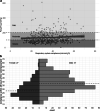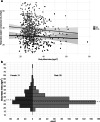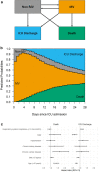An appraisal of respiratory system compliance in mechanically ventilated covid-19 patients
- PMID: 34108029
- PMCID: PMC8188162
- DOI: 10.1186/s13054-021-03518-4
An appraisal of respiratory system compliance in mechanically ventilated covid-19 patients
Abstract
Background: Heterogeneous respiratory system static compliance (CRS) values and levels of hypoxemia in patients with novel coronavirus disease (COVID-19) requiring mechanical ventilation have been reported in previous small-case series or studies conducted at a national level.
Methods: We designed a retrospective observational cohort study with rapid data gathering from the international COVID-19 Critical Care Consortium study to comprehensively describe CRS-calculated as: tidal volume/[airway plateau pressure-positive end-expiratory pressure (PEEP)]-and its association with ventilatory management and outcomes of COVID-19 patients on mechanical ventilation (MV), admitted to intensive care units (ICU) worldwide.
Results: We studied 745 patients from 22 countries, who required admission to the ICU and MV from January 14 to December 31, 2020, and presented at least one value of CRS within the first seven days of MV. Median (IQR) age was 62 (52-71), patients were predominantly males (68%) and from Europe/North and South America (88%). CRS, within 48 h from endotracheal intubation, was available in 649 patients and was neither associated with the duration from onset of symptoms to commencement of MV (p = 0.417) nor with PaO2/FiO2 (p = 0.100). Females presented lower CRS than males (95% CI of CRS difference between females-males: - 11.8 to - 7.4 mL/cmH2O p < 0.001), and although females presented higher body mass index (BMI), association of BMI with CRS was marginal (p = 0.139). Ventilatory management varied across CRS range, resulting in a significant association between CRS and driving pressure (estimated decrease - 0.31 cmH2O/L per mL/cmH20 of CRS, 95% CI - 0.48 to - 0.14, p < 0.001). Overall, 28-day ICU mortality, accounting for the competing risk of being discharged within the period, was 35.6% (SE 1.7). Cox proportional hazard analysis demonstrated that CRS (+ 10 mL/cm H2O) was only associated with being discharge from the ICU within 28 days (HR 1.14, 95% CI 1.02-1.28, p = 0.018).
Conclusions: This multicentre report provides a comprehensive account of CRS in COVID-19 patients on MV. CRS measured within 48 h from commencement of MV has marginal predictive value for 28-day mortality, but was associated with being discharged from ICU within the same period. Trial documentation: Available at https://www.covid-critical.com/study .
Trial registration: ACTRN12620000421932.
Keywords: ARDS; COVID-19; Compliance; Mechanical ventilation; SARS-CoV-2.
Conflict of interest statement
GLB and JF received research funds, through their affiliated institution from Fisher & Paykel. All remaining authors do not have any conflict of interest related to this report.
Figures









References
-
- Karagiannidis C, Mostert C, Hentschker C, Voshaar T, Malzahn J, Schillinger G, et al. Case characteristics, resource use, and outcomes of 10 021 patients with COVID-19 admitted to 920 German hospitals: an observational study. Lancet Respir Med [Internet]. Elsevier; 2020 [cited 2020 Aug 6];0. Available from: https://linkinghub.elsevier.com/retrieve/pii/S2213260020303167. - PMC - PubMed
Publication types
MeSH terms
Associated data
Grants and funding
LinkOut - more resources
Full Text Sources
Medical
Miscellaneous

